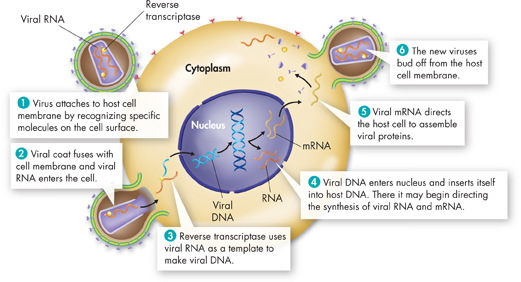
FIGURE 35–18 HIV Infection HIV travels through the blood, where it binds to receptors on helper T cells. Inside the cell, the viral DNA directs the cell to produce many new viruses. These new viruses are quickly released back into the blood, where they infect more cells. Apply Concepts In what steps are changes to HIV's genetic information most likely to occur?
dHIV  In 1983, researchers identified the cause of AIDS—a virus they called human immunodeficiency virus (HIV). HIV is deadly for two reasons. First, HIV can hide from the defenses of the immune system. Second, HIV attacks key cells within the immune system, leaving the body with inadequate protection against other pathogens.
In 1983, researchers identified the cause of AIDS—a virus they called human immunodeficiency virus (HIV). HIV is deadly for two reasons. First, HIV can hide from the defenses of the immune system. Second, HIV attacks key cells within the immune system, leaving the body with inadequate protection against other pathogens.
HIV is a retrovirus that carries its genetic information in RNA, rather than DNA. When HIV attacks a cell, it binds to receptor molecules on the cell membrane and inserts its contents into the cell. Figure 35–18 explains how HIV replicates inside a host cell.
MYSTERY CLUE

As with HIV, blood tests of patients with the mystery disease revealed antibodies to the disease. What could be a reason why the immune system cannot overcome the disease?
Target: T Cells Among HIV's main targets are helper T cells—the command centers of the specific immune response. Over time, HIV destroys more and more T cells, crippling the ability of the immune system to fight HIV and other pathogens. The progression of HIV infection can be monitored by counting helper T cells. The fewer helper T cells, the more advanced the disease, and the more susceptible the body becomes to other diseases. When an HIV-infected person's T cell count reaches about one sixth the normal level, he or she is diagnosed with AIDS.
HIV Transmission Although HIV is deadly, it is not easily transmitted. It is not transmitted through coughing, sneezing, sharing clothes, or other forms of casual contact. HIV can only be transmitted through contact with infected blood, semen, vaginal secretions, or breast milk. The four main ways that HIV is transmitted are sexual intercourse with an infected person; sharing needles with an infected person; contact with infected blood or blood products; or from an infected mother to her child during pregnancy, birth, or breast-feeding.
 In Your Notebook Make a flowchart that shows the steps of HIV infection and the development of AIDS.
In Your Notebook Make a flowchart that shows the steps of HIV infection and the development of AIDS.

Table of Contents
- Formulas and Equations
- Applying Formulas and Equations
- Mean, Median, and Mode
- Estimation
- Using Measurements in Calculations
- Effects of Measurement Errors
- Accuracy
- Precision
- Comparing Accuracy and Precision
- Significant Figures
- Calculating With Significant Figures
- Scientific Notation
- Calculating With Scientific Notation
- Dimensional Analysis
- Applying Dimensional Analysis




